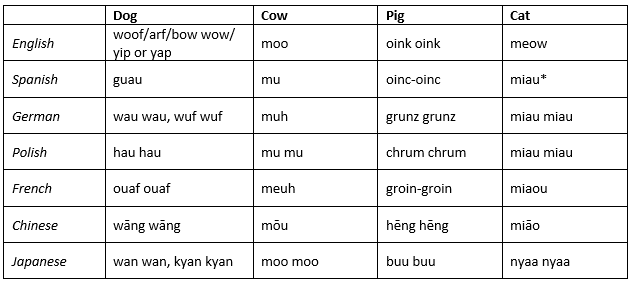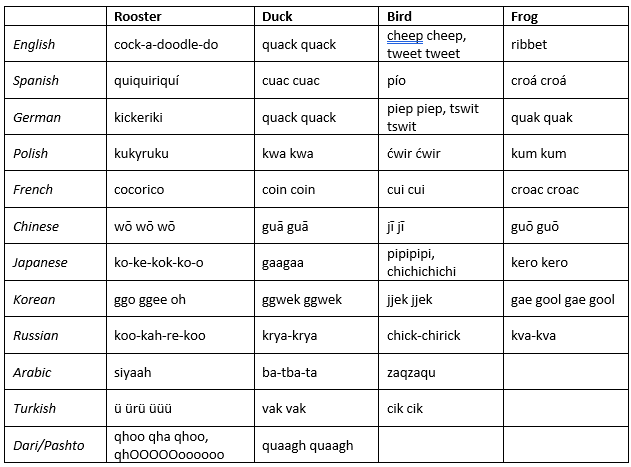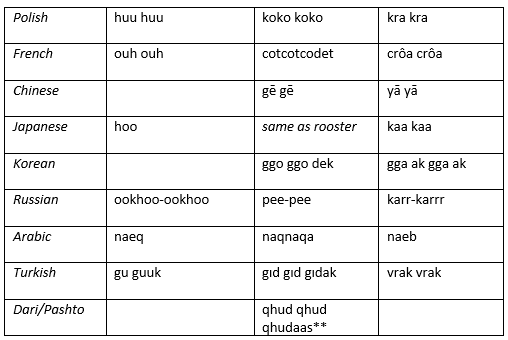
Have you ever thought about onomatopoeias in different languages? As a kid, I remember seeing a catchy slogan on the trucks of a local roofing company. Each truck had a picture of a dog with the words “Roof roof—how’s yours?”
To native English speakers, a variant onomatopoeia for a dog’s bark (roof, or more commonly ruff) makes for a clever play on words with the covering, or “roof,” of a house. But a non-native English speaker might puzzle a little longer over the slogan or miss the message altogether. To someone who grew up speaking Korean, a dog doesn’t go roof roof, it goes mung mong. A native Polish speaker would say a dog goes hau hau. A Spanish speaker, guau guau.
How can one dog’s bark make all those sounds?
Certain animals can be found everywhere, but depending on the language spoken in that part of the world, the “sounds” ascribed to commonplace animals can be relatively similar or quite different. It’s not only what the animal is doing with its vocal cords, but also what the listener is listening for.
Every language is based on a set of sounds or a phonetic system that determines what sounds are used and how they are paired together. Even something like an onomatopoeia—a word that represents a sound by imitating it, like thunk, whack, or roof roof—is influenced by a language’s phonemes even as the word tries to encapsulate a sound. This means an onomatopoeia created to represent an animal sound is still considered a word and it obeys the rules of that language. So animals are, in a sense, speaking the language of the listener.
Examples
For example, linguist Arika Okrent notes that in Japanese, words never start with a qu- sound. To a Japanese speaker, a duck cannot say quack quack (an English onomatopoeia) but can say ga-ga. In Mandarin Chinese, words cannot end with the “f” sound, so instead of saying woof woof, dogs say wāng wāng.
I made a brief list of common animals and their sounds in some DLS languages, which you can view below. For a challenge, cover the top two rows of each table and try to guess which animal is being depicted.





*Another fun onomatopoeia: in Spanish, a cat’s purr is a “rrorroneo”.
**Gh and Qh are sounds that do not exist in English.
I enjoyed compiling the sounds and seeing how similar and different the onomatopoeias were from each other. Animal sounds that are short, like the lowing of a cow, had similar onomatopoeias across many languages (moo, mu, muh, meuh, mōu). A rooster’s crowing, however, contains lots of sounds and subsequently has many different onomatopoeias from language to language (ggo ggee oh, siyaah, ü ürü üüü, kukyruku).
Culture
We can also learn a little about a language user’s culture from its animal onomatopeias. The Swedish language has an onomatopoeia for the sound a moose makes (broel), while some languages, including English, don’t. Evidently, Sweden has the highest moose-per-square-kilometer ratio of any country. So, the odds of a Swede coming across and hearing a moose are higher than in other countries, which is reflected in its language. Some languages like English and Russian have several different onomatopoeias for dogs (English: ruff ruff, woof woof, bow wow, yap yap, and arf arf, with yip yip for little dogs specifically; Russian: gav-gav, guf-guf, hav-hav, with tyav-tyav for little dogs or puppies), implying dogs play a more active part in those cultures.
Pop Culture
Words from other languages are being increasingly exchanged, thanks to today’s innovation in communication. Some animal onomatopoeias from other languages have entered American pop culture lingo, particularly Japanese animal sounds. Ever seen the Japanese YouTube video “Nyan Cat”? (It’s a flying cartoon cat that has a pink Pop-Tart for a torso and leaves behind a pixelated rainbow trail.) The name is a combination of two languages—the English word for the animal and corresponding animal sound in Japanese, nyaa. The Pokemon called Pikachu is another Japanese cultural icon that stems from animal sounds. His name is a combination of pika, the sound of something shiny or new, and chuu, the sound a mouse makes. Something as small as one language’s onomatopoeia for a cat’s meow or a mouse’s squeak can make its way around the world.
Next time you hear a dog’s bark or cat’s meow, try listening for a different onomatopoeia than you’re used to; maybe you’ll hear how a dog’s bark can sound like wan wan, hau hau, or mung mong.
More Reading
For further reading, here’s a site with cute illustrations for each animal and various onomatopoeia from other languages: https://www.boredpanda.com/animal-sounds-different-languages-james-chapman/?utm_source=google&utm_medium=organic&utm_campaign=organic.
Read more about the science behind animal sounds in other languages here: https://www.quickanddirtytips.com/education/grammar/why-animal-sounds-are-different-in-different-languages
By Stephanie Fudge
For more DLS, check out other blogs and visit us on Facebook, LinkedIn, Instagram, or Twitter!




